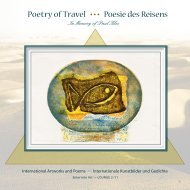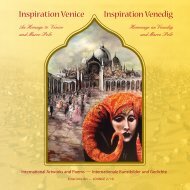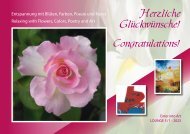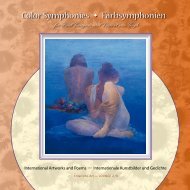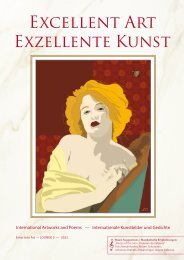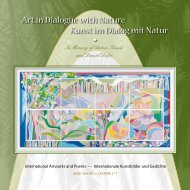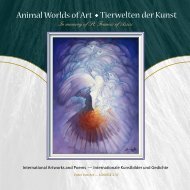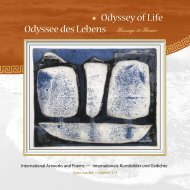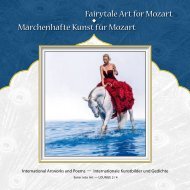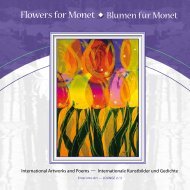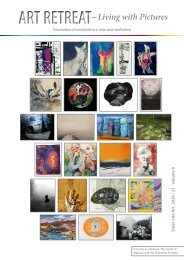Isao Kobayashi - Mysterious Worlds - Geheimnisvolle Welten
The trademarks of Isao Kobayashi’s works are their multi-layered depth and their tonal beauty. The artist is an excellent observer of hidden details. His works often resemble emotional soundscapes in different shades of gold, and prompt observers to remember the future from the past. The solo book of the Japanese artist also aims at inspiring readers to expand their perception to the tonal aspects of art and poetry. Inspired by the artworks and a topic-related selection of her haiku poetry, the editor chose the koto piece “Akikaze no Kyoku” (Melody of the Autumn Wind) by Mitsuzaki Kengyô. She also invites you to an imaginary opening of an art exhibition with an excellent wine recommendation. The printed book is available in the book trade and in internet bookshops. Softcover: ISBN 978-3-98527-070-5, Publisher: Re Di Roma-Verlag, Language: English, German, Size: 26 x 21 cm Isao Kobayashis Kunstwerke wirken durch ihre vielfältige Tiefschichtigkeit und tonale Schönheit. Kobayashi ist ein exzellenter Beobachter verborgener Details. Seine Bilder gleichen oft emotionalen Klanggemälden verschiedener Goldtöne und fordern dazu auf, sich aus der Vergangenheit in die Zukunft hinein zu erinnern. Das Solobuch des japanischen Künstlers soll dazu anregen, Kunst und Poesie auch in ihrer tonalen Aussage zu erfassen. In Harmonie mit den Kunstbildern und einer themenbezogenen Auswahl ihrer Haiku-Lyrik fiel die musische Wahl der Herausgeberin auf das Koto-Stück „Akikaze No Kyoku“ (Melodie des Herbstwindes) von Mitsuzaki Kengyô. Gleichwohl lädt sie mit einer exzellenten Weinempfehlung zu einer imaginären Vernissage ein.
The trademarks of Isao Kobayashi’s works are their multi-layered depth and their tonal beauty. The artist is an excellent observer of hidden details. His works often resemble emotional soundscapes in different shades of gold, and prompt observers to remember the future from the past. The solo book of the Japanese artist also aims at inspiring readers to expand their perception to the tonal aspects of art and poetry. Inspired by the artworks and a topic-related selection of her haiku poetry, the editor chose the koto piece “Akikaze no Kyoku” (Melody of the Autumn Wind) by Mitsuzaki Kengyô. She also invites you to an imaginary opening of an art exhibition with an excellent wine recommendation.
The printed book is available in the book trade and in internet bookshops. Softcover: ISBN 978-3-98527-070-5, Publisher: Re Di Roma-Verlag, Language: English, German, Size: 26 x 21 cm
Isao Kobayashis Kunstwerke wirken durch ihre vielfältige Tiefschichtigkeit und tonale Schönheit. Kobayashi ist ein exzellenter Beobachter verborgener Details. Seine Bilder gleichen oft emotionalen Klanggemälden verschiedener Goldtöne und fordern dazu auf, sich aus der Vergangenheit in die Zukunft hinein zu erinnern. Das Solobuch des japanischen Künstlers soll dazu anregen, Kunst und Poesie auch in ihrer tonalen Aussage zu erfassen. In Harmonie mit den Kunstbildern und einer themenbezogenen Auswahl ihrer Haiku-Lyrik fiel die musische Wahl der Herausgeberin auf das Koto-Stück „Akikaze No Kyoku“ (Melodie des Herbstwindes) von Mitsuzaki Kengyô. Gleichwohl lädt sie mit einer exzellenten Weinempfehlung zu einer imaginären Vernissage ein.
Create successful ePaper yourself
Turn your PDF publications into a flip-book with our unique Google optimized e-Paper software.
<strong>Isao</strong> <strong>Kobayashi</strong><br />
<strong>Mysterious</strong> <strong>Worlds</strong><br />
<strong>Geheimnisvolle</strong> <strong>Welten</strong><br />
Von Gabriele Walter und Kurt Ries<br />
1
<strong>Isao</strong> <strong>Kobayashi</strong><br />
<strong>Mysterious</strong> <strong>Worlds</strong><br />
<strong>Geheimnisvolle</strong> <strong>Welten</strong><br />
14 artworks by<br />
14 Kunstbilder von<br />
<strong>Isao</strong> <strong>Kobayashi</strong><br />
10 haiku poems by<br />
10 Haiku-Gedichte von<br />
Gabriele Walter<br />
2 Detail: The Proof Of The Existence No. 115<br />
3
Surrealistic Fascination<br />
The Japanese artist <strong>Isao</strong> <strong>Kobayashi</strong> won the first prize<br />
in the international competition “Enter into Art – LOUNGE<br />
2”. The jury consisted of 13 members from 12 countries. His<br />
award-winning work can be seen on the cover of the bilingual<br />
art and gift book “A Fine Art Journey”. In addition,<br />
his achievement was honored with the solo art book that is<br />
now in front of you.<br />
The trademarks of <strong>Isao</strong> <strong>Kobayashi</strong>’s works are their<br />
multi-layered depth and their tonal beauty. The artist is<br />
an excellent observer of hidden details. In a world full of<br />
secrets and mysteries, his paintings are signposts towards<br />
the truth. With his novelistic and dramatic touch, he takes<br />
observers into a mysterious universe, opening the door to<br />
our imagination.<br />
With his intricate knowledge of digital technique, he<br />
points towards forgotten paths of wisdom. His works are<br />
dominated by symbolism and invite observers to look at<br />
them in depth. Taking them on a journey of discoveries,<br />
they guide them towards fascinating, unexpected insights.<br />
At the same time, <strong>Kobayashi</strong>’s works can never be read<br />
and grasped fully. The artist succeeds in turning antithesis<br />
into synthesis, giving his works a visually captivating<br />
depth. Muted colors develop a dynamic that generates a<br />
surreal visual context and releases new energy.<br />
Surrealistische Faszination<br />
Der japanische Künstler <strong>Isao</strong> <strong>Kobayashi</strong> hat bei dem<br />
internationalen Wettbewerb „Enter into Art – LOUNGE 2“<br />
den ersten Preis gewonnen. Die Jury bestand aus 13 Mitgliedern<br />
aus 12 Ländern. Sein Preisträgerbild ist auf dem<br />
Buchcover des zweisprachigen Kunst- und Geschenkbuches<br />
„Weltreise mit Kunstbildern“ zu sehen. Darüber hinaus<br />
wurde er mit dem vorliegenden Solo-Kunstbuch belohnt.<br />
<strong>Isao</strong> <strong>Kobayashi</strong>s Kunstwerke wirken durch ihre vielfältige<br />
Tiefschichtigkeit und tonale Schönheit. <strong>Kobayashi</strong> ist<br />
ein exzellenter Beobachter verborgener Details. In einer<br />
Welt voller Geheimnisse und Rätsel möchte er mit seinen<br />
Bildern einen Weg zur Wahrheit weisen. Mit einer Mischung<br />
aus Romanhaftigkeit und Drama entführt er den<br />
Betrachter in ein geheimnisvolles Universum.<br />
Dabei steht die Tür zu unserer Fantasiewelt offen. Mit<br />
filigraner Beherrschung der digitalen Technik weist der<br />
Künstler auf vergessene Pfade der Weisheit hin. Die vom<br />
Symbolismus beherrschten Bilder lassen sich beobachten<br />
und durchdringen. Sie nehmen den Betrachter auf eine<br />
Entdeckungsreise mit und sind Wegweiser zu spannenden<br />
und unerwarteten Einsichten.<br />
Dennoch können die Bilder scheinbar nicht vollständig<br />
ausgelesen und gedeutet werden. Dem Künstler gelingt<br />
es, aus der Antithese eine Synthese werden zu lassen und<br />
dadurch seinen Werken eine optisch fesselnde Bildtiefe zu<br />
verleihen. In gedecktem Kolorit erwächst aus Gedankengebilden<br />
eine im Detail nicht wiederholbare Dynamik, die<br />
einen surrealen Bildkontext erzeugt und neue Energien<br />
freisetzt.<br />
https://yobisakajin.jimdofree.com/ - yobisakajin.77911@gmail.com<br />
Detail: The α Box No. 17<br />
4<br />
5
Music Suggestion<br />
„Akikaze no Kyoku“ by Mitsuzaki Kengyô<br />
The introduction of a musical work aims at inspiring readers<br />
to expand their perception to the tonal aspects of art<br />
and poetry. Inspired by the artworks and a topic-related<br />
selection of the haiku poetry, the editors chose the koto<br />
piece “Akikaze no Kyoku” (Melody of the Autumn Wind), for<br />
which the composer developed a specific way of tuning<br />
the instrument - the “autumn wind scale”.<br />
<strong>Isao</strong> <strong>Kobayashi</strong>’s works often resemble emotional<br />
soundscapes in different shades of gold, and prompt observers<br />
to remember the future from the past. The sound<br />
of the koto, the Japanese national instrument, is described<br />
as melancholy and deeply moving. It can be influenced by<br />
the so-called bridges running across the strings. The shape<br />
of the instrument is often compared to a dragon.<br />
Legend has it that Mitsuzaki once visited the Benzaiten<br />
shrine on Chikubu Island. The island is known to be a dwelling<br />
place of the gods and possess great spiritual powers<br />
and healing qualities. There, in a dream, the composer had<br />
a vision of himself writing the song. The “Kengyô“ part of<br />
his name designates the highest rank a blind musician<br />
could be awarded during the Edo period. Seemingly, the<br />
depths of the sea near the dream-like island on Lake Biwa<br />
not far from Kyoto harbor fascinating archeological secrets.<br />
Musikalische Empfehlung<br />
„Akikaze no Kyoku“ von Mitsuzaki Kengyô<br />
Die musikalische Empfehlung soll dazu anregen, Kunst<br />
und Poesie auch in ihrer tonalen Aussage zu erfassen. In<br />
Harmonie mit den Kunstbildern und einer themenbezogenen<br />
Auswahl der Haiku-Lyrik fiel die Wahl der Herausgeber<br />
auf das Koto-Stück „Akikaze No Kyoku“ (Melodie des<br />
Herbstwindes), wofür der berühmte Komponist Mitsuzaki<br />
Kengyô eine besondere Stimmung des Musikinstrumentes<br />
entwickelt hatte: „Stimmung für Herbstwind“.<br />
<strong>Isao</strong> <strong>Kobayashi</strong>s Bilder gleichen oft emotionalen Klanggemälden<br />
verschiedener Goldtöne und fordern dazu auf,<br />
sich aus der Vergangenheit in die Zukunft hinein zu erinnern.<br />
Der Klang des japanischen Nationalinstruments Koto<br />
wird als melancholisch und tief bewegend bezeichnet. Er<br />
lässt sich durch die sog. Stege beeinflussen, über die die<br />
Saiten verlaufen. Die Form des Instruments wird oft mit einem<br />
Drachen verglichen.<br />
Laut einer Legende besuchte Mitsuzaki einst den<br />
Benzaiten-Schrein auf der Insel Chikubu. Das Eiland gilt<br />
als Heimat der Götter und als spiritueller Ort magischer<br />
Heilkräfte. In einem Traum hatte der Komponist dort eine<br />
Vision, dieses Lied zu schreiben. Der Teil seines Namens<br />
„Kengyô“ ist die Bezeichnung des höchsten Ranges, den<br />
man während der Edo-Zeit blinden Musikern verlieh.<br />
Gleichsam werfen die Meerestiefen bei dem traumhaften<br />
Inselchen im Biwa-See unweit von Kyoto faszinierende archäologische<br />
Rätsel auf.<br />
Detail: The Proof Of The Existence No. 91<br />
4<br />
5
The Proof Of The Existence No. 9, 2018, digital print, 32 x 40 cm<br />
6<br />
7
Plucking the reeds like<br />
The strings of a harp, the wind<br />
Plays its first notes: Fall.<br />
Mit Harfenklang im<br />
Schilfrohr der Wind den Auftakt<br />
Des Herbstes anspielt.<br />
Temple columns<br />
Growing out of the blue<br />
Sea, worn by the wind’s wild roar.<br />
Tempelsäulen<br />
Dem Seeblau entwachsen.<br />
Abgenagt vom Windestosen.<br />
Born from ocean froth,<br />
The rock silently withstands<br />
The force of the waves.<br />
Schaumgeboren der<br />
Fels schweigend dem Tosen der<br />
Wellen widersteht.<br />
In front of purple<br />
Clouds, a buzzard sits. Sea wind<br />
Ruffling its feathers.<br />
Vor purpur Wolken<br />
Ein Bussard hockt. Der Seewind<br />
Sträubt ihm die Federn.<br />
Murmuring, raging,<br />
Speeding along. The sea storm<br />
Sings canons at night.<br />
Raunen, Toben und<br />
Sausen. Des Seesturmes Nacht<br />
Ihren Kanon singt.<br />
8 9
Art Meditation<br />
Imagine you are at an exhibition featuring these<br />
works, mindfully observing them. Close your eyes and<br />
observe your breath, or listen to it, until you feel pleasantly<br />
calm. Pick an artwork:<br />
• What is this artwork about? What is special about<br />
it?<br />
• Take your time and analyze the colors and shapes<br />
in this work. Feel their sound!<br />
• What spontaneous associations does this artwork<br />
trigger in you?<br />
• What would you say is “that certain something”<br />
about it - that mysterious aspect that is difficult<br />
put into words, and that has sprung directly from<br />
the artist’s soul?<br />
Kunstmeditation<br />
Stell dir vor, du würdest eine Ausstellung mit den<br />
Kunstwerken besuchen und sie in achtsamer Weise<br />
betrachten. Schließe deine Augen und beobachte<br />
bzw. höre deinen Atem so lange, bis du angenehme<br />
Ruhe in dir spürst und suche dir danach ein Kunstwerk<br />
aus:<br />
• Worum geht es in dem Kunstwerk? Welche Besonderheiten<br />
weist es auf?<br />
• Nimm dir Zeit und analysiere die Farben und die<br />
Formen! Spüre ihren Klang!<br />
• Welche Assoziationen weckt das Werk bei dir<br />
spontan?<br />
• Worin liegt das <strong>Geheimnisvolle</strong>, Unaussprechliche,<br />
das wohl rein aus der Seele quellende des<br />
Künstlers?<br />
Detail: The Proof Of The Existence No. 100<br />
10<br />
11
The α Box No. 17, 2018, digital print, 64 x 80 cm<br />
12<br />
13
The Proof Of The Existence No. 21, 2018, digital print, 20 x 20 cm<br />
The Proof Of The Existence No. 23, 2018, digital print, 40 x 32 cm<br />
14<br />
15
The Proof Of The Existence No. 54, 2019, digital print, 64 x 80 cm<br />
16<br />
17
18 Detail: The Proof Of The Existence No. 114 Detail: The Proof Of The Existence No. 23<br />
19
The Proof Of The Existence No. 103, 2020, digital print, 20 x 20 cm<br />
20<br />
21
The Proof Of The Existence No. 122, 2021, digital print, 60 x 48 cm<br />
The Proof Of The Existence No. 97, 2020, digital print, 60 x 48 cm<br />
22<br />
23
The Proof Of The Existence No. 91, 2020, digital print, 48 x 60 cm<br />
24<br />
25
26 Detail: The Proof Of The Existence No. 103<br />
Detail: The Proof Of The Existence No. 100<br />
27
Keep Out No. 10, 2018, digital print, 48 x 60 cm<br />
28<br />
29
The α Box No. 18, 2019, digital print, 64 x 80 cm<br />
The Proof Of The Existence No. 100, 2020, digital print, 50 x 40 cm<br />
30<br />
31
The Proof Of The Existence No. 115, 2020, digital print, 80 x 100 cm<br />
32<br />
33
Detail: The Proof Of The Existence No. 97<br />
Detail: Keep Out No. 10<br />
34 35
Only ravens call<br />
Amid the wind’s murmur and<br />
The lake’s lapping sound.<br />
Nur Rabenrufe<br />
Rundum das Windraunen und<br />
Das Plätschern am See.<br />
After the storm down<br />
By the lake, drops hurry off<br />
In sparkling circles.<br />
Nach dem Sturm dort<br />
Am See Tropfen zu schillernden<br />
Kreisen verhuschen.<br />
Riding on the clouds,<br />
The misty moon seems driven<br />
Only by the wind.<br />
Auf Wolkenfahrt der<br />
Nebelmond scheinbar nur<br />
Vom Winde getrieben.<br />
The quiet chatter<br />
Of the last leaves clinging to<br />
The big maple tree.<br />
Leise plappert mit<br />
Seinen letzten Blättern der<br />
Dicke Ahornbaum.<br />
Quiet alleyway<br />
The voice of a man telling<br />
Tales about rough winds.<br />
In stillen Gassen<br />
Eine Mannesstimme erzählt<br />
Vom rauen Wind.<br />
36 37
Preview chitchat<br />
Art, wine, poetry and music<br />
Why wine above all is drunk at the opening of exhibitions<br />
has surely to do with art and wine corresponding<br />
best with each other at the level of spiritual enjoyment. Exciting<br />
wines possess something like a karma - historically<br />
they have been received like a painting or a symphonic<br />
work.<br />
As such wine drinking is no muse, yet it is said that only<br />
those who can really enjoy wine are those who also have<br />
an affinity toward aesthetic things, like enjoying pictures,<br />
reading poems and appreciating music. As well as art, wines<br />
need time and patience to mature. Also the sensuality<br />
in wine can only be tasted when its intangible magic can<br />
be calmly transferred to those who surrender to it.<br />
In order to grasp the emotional nature of an image, one<br />
can - like mindful wine tasting - carry out a meditation with<br />
art, color and poetry, and instead of wine, enjoy a work of<br />
art.<br />
Wine suggestion:<br />
The 125 km long Nahe river in Germany flows into the<br />
Rhine near Bingen and gives its name to a unique winegrowing<br />
region with more than 180 different soil formations.<br />
After the Romans, the monasteries started growing<br />
wine on the Nahe in the early Middle Ages.<br />
Guided by a dream, St. Disibod came to a spring on<br />
the Disibodenberg as an Irish missionary on his journey<br />
around the year 640. Later St. Boniface also visited<br />
the mountain. The famous Hildegard von Bingen built a<br />
women's cell here.<br />
Vernissagegeplauder<br />
Kunst, Wein, Lyrik und Musik<br />
Warum auf einer Vernissage vor allem Wein getrunken<br />
wird, hat gewiss auch damit zu tun, dass Kunst und Wein<br />
auf der Ebene des seelischen Genusses am besten miteinander<br />
korrespondieren. Spannende Weine besitzen so<br />
etwas wie ein Karma, sie haben eine Rezeptionsgeschichte<br />
wie ein Gemälde oder ein sinfonisches Werk.<br />
Das Weintrinken als solches ist keine Muse, jedoch kann<br />
angeblich nur derjenige den Wein wirklich genießen, der<br />
eine Affinität zu musischen Dingen hat, das heißt sich an<br />
Bildern erfreut, Gedichte liest und Musik zu schätzen weiß.<br />
Ebenso wie die Kunst braucht der Wein Zeit und Geduld,<br />
um sich zu entfalten. Auch die Sinnlichkeit im Wein wird<br />
erst schmeckbar, wenn sich das Nichtgreifbare und Zauberhafte<br />
in aller Ruhe auf jenen übertragen kann, der sich<br />
ihm hingibt.<br />
Um das emotionale Wesen eines Bildes zu erfassen kann<br />
man - analog zu einer achtsamen Weinverkostung - eine<br />
Meditation mit Kunst, Farbe und Lyrik durchführen und<br />
anstelle von Wein ein Kunstwerk genießen.<br />
Weinempfehlung:<br />
Das 125 km lange Flüsschen Nahe in Deutschland mündet<br />
bei Bingen in den Rhein und gibt seinen Namen auch<br />
für ein einzigartiges Weinbaugebiet mit mehr als 180 verschiedenen<br />
Bodenformationen. Nach den Römern betrieben<br />
ab dem frühen Mittelalter die Klöster den Weinbau an<br />
der Nahe.<br />
Geleitet durch einen Traum kam der Hl. Disibod um das<br />
Jahr 640 als irischer Missionar auf seiner Wanderschaft<br />
zu einer Quelle auf dem Disibodenberg. Später besuchte<br />
auch St. Bonifatius den Berg. Die berühmte Hildegard von<br />
Bingen errichtete hier eine Frauenklause.<br />
38<br />
Detail: The Proof Of The Existence No. 54<br />
39
Detail: The α Box No. 18<br />
40 Detail: The Proof Of The Existence No. 21<br />
41
<strong>Mysterious</strong> <strong>Worlds</strong><br />
<strong>Geheimnisvolle</strong> <strong>Welten</strong><br />
Artworks by <strong>Isao</strong> <strong>Kobayashi</strong><br />
Haiku poems by Gabriele Walter<br />
Kunstbilder von <strong>Isao</strong> <strong>Kobayashi</strong><br />
Haiku-Gedichte von Gabriele Walter<br />
Imprint<br />
Editors: Gabriele Walter and Kurt Ries<br />
Written by: Gabriele Walter<br />
Cover / artistic design by: Kurt Ries<br />
Translated into English by: Anna Sanner<br />
(and Gabriele Walter - p. 39)<br />
Copyright:<br />
Gabriele Walter and Kurt Ries<br />
Pützstücker Straße 45<br />
D-53639 Königswinter<br />
Tel. 0049 2244 3823<br />
www.meditaterra.de<br />
www.enterintoart.com<br />
Impressum:<br />
Herausgeber: Gabriele Walter und Kurt Ries<br />
Text: Gabriele Walter<br />
Cover / künstlerische Gestaltung: Kurt Ries<br />
Übersetzung ins Englische: Anna Sanner<br />
(und Gabriele Walter - S. 39)<br />
Copyright:<br />
Gabriele Walter und Kurt Ries<br />
Pützstücker Straße 45<br />
D-53639 Königswinter<br />
Tel. 0049-2244-3823<br />
www.meditaterra.de<br />
www.enterintoart.com<br />
© Königswinter, 2021<br />
All rights reserved. Any reprinting in full or in part, any distribution by film, broadcasting, or television,<br />
any publication on the internet, or through photomechanical reproduction, sound recording, or data processing<br />
systems of any kind requires the written consent of the publisher.<br />
Alle Rechte vorbehalten. Nachdruck, auch auszugsweise, sowie die Verbreitung durch Film, Funk, Fernsehen<br />
und Internet, durch fotomechanische Wiedergabe, Tonträger und Datenverarbeitungssysteme jeglicher<br />
Art nur mit schriftlicher Genehmigung der Herausgeber.<br />
Translation of the following page:<br />
Bibliographic information of the German National Library. The German National Library lists this publication<br />
in the German National Bibliography; detailed bibliographic data are available on the Internet<br />
– http://dnb.ddb.de<br />
42 43
TThe trademarks of <strong>Isao</strong> <strong>Kobayashi</strong>’s works are their multilayered<br />
depth and their tonal beauty. The artist is an excellent<br />
observer of hidden details. His works often resemble<br />
emotional soundscapes in different shades of gold, and prompt<br />
observers to remember the future from the past. The solo book<br />
of the Japanese artist also aims at inspiring readers to expand<br />
their perception to the tonal aspects of art and poetry. Inspired<br />
by the artworks and a topic-related selection of her haiku poetry,<br />
the editor chose the koto piece “Akikaze no Kyoku” (Melody<br />
of the Autumn Wind) by Mitsuzaki Kengyô.She also invites you to<br />
an imaginary opening of an art exhibition with an excellent wine<br />
recommendation. She also invites you to an imaginary opening of<br />
an art exhibition with an excellent wine recommendation.<br />
<strong>Isao</strong> <strong>Kobayashi</strong>s Kunstwerke wirken durch ihre vielfältige<br />
Tiefschichtigkeit und tonale Schönheit. <strong>Kobayashi</strong> ist ein exzellenter<br />
Beobachter verborgener Details. Seine Bilder gleichen<br />
oft emotionalen Klanggemälden verschiedener Goldtöne<br />
und fordern dazu auf, sich aus der Vergangenheit in die Zukunft<br />
hinein zu erinnern. Das Solobuch des japanischen Künstlers soll<br />
dazu anregen, Kunst und Poesie auch in ihrer tonalen Aussage zu<br />
erfassen. In Harmonie mit den Kunstbildern und einer themenbezogenen<br />
Auswahl ihrer Haiku-Lyrik fiel die musische Wahl der<br />
Herausgeberin auf das Koto-Stück „Akikaze No Kyoku“ (Melodie<br />
des Herbstwindes) von Mitsuzaki Kengyô. Gleichwohl lädt sie mit<br />
einer exzellenten Weinempfehlung zu einer imaginären Vernissage<br />
ein.<br />
44




